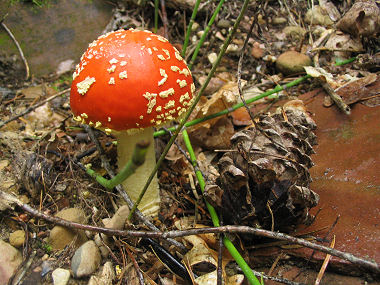Fly Agaric is a member of the is a member
of the Amanitaceae Family, a family of mushrooms that includes both
edible mushrooms, and some of the most poisonous (including the Death
Cap).
 The
mushroom has a convex top (also called a pileus) which flattens as it
ages, growing from 3-10 inches in diameter.
The underside of the pileus consists of white, closely spaced gills. The
cap is typically bright red in color with white warts and a white stem
that grows from 3-7 inches in height. The
mushroom has a convex top (also called a pileus) which flattens as it
ages, growing from 3-10 inches in diameter.
The underside of the pileus consists of white, closely spaced gills. The
cap is typically bright red in color with white warts and a white stem
that grows from 3-7 inches in height.
|
Fly Agaric is eaten some parts of
the world because it can induce hallucinations. However, this
species also contains a number of toxins that can be fatal if
present in sufficient quantity. Several deaths have been
attributed to this species in the US. |
In the southwest, Fly Agaric
typically grows in moist pine woodlands. The
mushroom reproduces by means of white, dust-like spores which are
dispersed by the wind.
|

